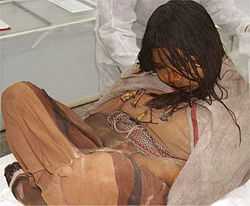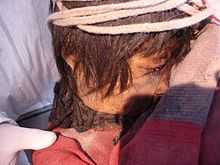Children of Llullaillaco
The Children of Llullaillaco or Children of the Cold are mummies discovered by Dr. Johan Reinhard and his archaeological team on 16 March 1999 at Mount Llullaillaco, which lies on the border of Chile and Argentina. The burial is believed to have taken place 500 years before. They are said to be the best preserved Inca mummies of all time.[1]
Discovery
Three days into their search for Inca sacrifice sites, Reinhard's team discovered the grave site containing two girls and one boy. Several gold, shell and silver statues, textiles and pottery were also found. The younger girl's body had been struck by lightning after her death, causing burn damage on body, especially her face and shoulder. The other two mummies were not struck by lightning. Statues made of precious metals and textiles were among the grave goods found.[1][2]
Examination


The oldest mummy, a girl found to be around the age of fifteen, was dubbed "La Doncella" which translates to "The Maiden". A bacterial infection was discovered in her lungs during an examination.[3] She wore a dress with her hair braided, along with a headdress. DNA testing indicated that the two girls were half sisters, where the boy had no relation.[4] La Doncella had been drugged by coca leaves and a maize beer known as chicha, dying in her sleep, a fate also shared by the other mummies.[2][4][5]
It is believed that La Doncella was an aclla, or Sun Virgin. That is, she was chosen and sanctified as a toddler to live with other girls and women who would become royal wives, priestesses, and sacrifices. The practice of ritual sacrifice in the Inca society was to ensure health, rich harvests and preferable weather.
"La niña del rayo", or "Lightning Girl" was approximately six years old when she was sacrificed.[4] Her face and part of her shoulder were damaged by a lightning strike that occurred after her death.[1]
The body of the boy had been tightly wrapped, as some of his ribs and pelvis were dislocated. He apparently died under stress, as vomit and blood was found on his clothing.[6] He was the only child that was tied up.
The mummies remain on display at the Museum of High Altitude Archaeology in Argentina.
| Wikimedia Commons has media related to Llullaillaco mummies. |
References
- ↑ 1.0 1.1 1.2 Sawyer, Kathy (7 April 1999). "Mummies of Inca Children Unearthed". Washington Post. Retrieved 21 July 2012.
- ↑ 2.0 2.1 Secretaría de Cultura de Salta Argentina – ORIGEN Y MISION. Maam.org.ar (2007-12-16). Retrieved on 2010-12-14.
- ↑ Waugh, Rob (2012-07-26). "Incan mummy frozen after human sacrifice still has infection in lungs after 500 years - giving new insight into diseases of the past". Associated Newspapers Ltd. Retrieved 8 November 2012.
- ↑ 4.0 4.1 4.2 Milner Halls, Kelly (2007). Mysteries of the Mummy Kids. Darby Creek Pub. p. 72. ISBN 158196059X.
- ↑ Wade, Lizzie (29 July 2013). "'Llullaillaco Maiden' May Have Been Drugged Before Sacrificed". Science Magazine.
- ↑ Child mummies yield 'grim' evidence. Metro.co.uk (2007-10-02). Retrieved on 2010-12-14.